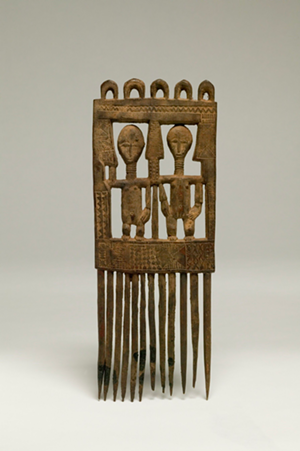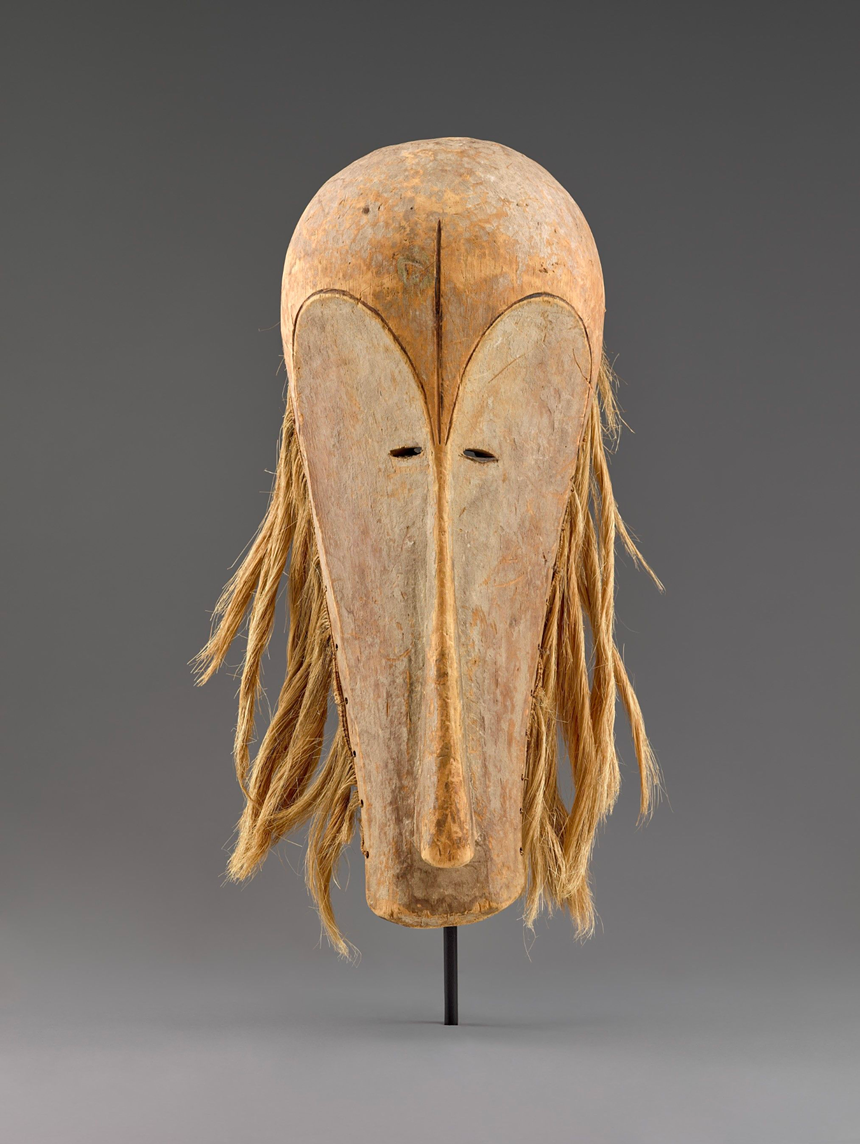It’s that kind of show. With some 800 works spanning a variety of countries, the collection draws from artistic traditions nearly as rich and diverse as the continent from which they came. It’s the kind of show where visitors can notice and learn more with each visit, where each work, from a tiny brass ring to a thirty-foot-wide quilt made from found bottle tops and copper wire, suggests a magnitude of meaning and history.
“One of the things we wanted to bring into the show is the diversity of Africa itself,” explains Director of Native Arts John Lukavic. “We have works from Egypt, from Nigeria, Ethiopia, from all over. You’ll see Islam represented, and you’ll see Eastern or Ethiopian Orthodox and Christian arts represented in the galleries. We're trying to show art in a variety of ways to show how truly diverse Africa is.”
Visitors are greeted by a familiar object upon entering the space: hand-carved hair picks from several countries, accompanied by a video and a quote from the singer Solange Knowles: “Don’t touch my hair, when it’s my feelings I wear.” The display sets an immediate tone of celebration and pride. “As we were preparing the show,” Lukavic explains, “one of the main things we wanted to get across was this concept of radical joy.”
Lukavic collaborated with Adekunle Adeniji, the Anderman Family Fellow for African Arts, to curate the show, with support from Karuna Srikureja and Jennie Hord. “We drew on conversations and research from Denver’s African diaspora and African-American communities, and this concept of radical joy is something people wanted to see represented here,” says Lukavic. “So there’s dance, there's movement, there's music. There's a lot of activity buzzing.”
Buzzing above the five stunning masks that hang on simple mannequins at the viewer’s eye level — rather than down near waist level, where they might be typically displayed — is footage from a Mende masquerade ceremony in Sierra Leone, showing one of the masks below as it would be seen in context: on a living, dancing person. Mixed-media choices such as these help visitors see the works before them as both artifacts of masterful craftsmanship and vital objects within living social environments, often meant to be touched or worn.
On another wall above the show reads a poignant quote from Léopold Sédar Senghor, the poet and first president of Senegal: “In Africa, art for art’s sake does not exist. All art is social.” In a Western museum, where viewers typically experience art in frames on white walls, the quote gently challenges visitors to approach the Arts of Africa collection differently — to not just observe the beauty in the works, but to imagine the landscapes, people and traditions that shaped them.
Choosing favorites from a collection like Arts of Africa almost defies part of the purpose of the show, which pushes visitors to reimagine their understanding of the role of art and to let go of traditional metrics of value. “I hate answering the favorites question because...there is so much responsibility not only to the arts that we have here and the artists who created them, but to the communities they're from,” says Lukavic. “In some of these communities, there is an inversion of aesthetics, where humility is so important that something plain and undecorated, mud-splattered, having been worn in ceremony, is more beautiful than the most highly beaded piece.”
Resisting reductive narratives — or inverting them, in some cases — is a thematic thread that weaves through the entire display, among many colorful others. While relatively small in square footage compared to the DAM’s other floors and collections, Arts of Africa is so dense with powerful works, you can’t go wrong spending extended time with any of them. But if you only have a moment on your first visit, here are a few highlights from the collection:
Ngil Mask, Fang Artist (1800s)
The Fang Ngil was a secret society in the region of what is now Gabon and Cameroon; its members wore long, intimidating wooden masks and served as the surrounding tribe’s judges and police. One of the rarest and most valuable pieces in the collection, the Ngil mask evokes age-old questions about authority in pre-colonial Africa. French colonialists outlawed the Ngil in 1910, and the society all but disappeared.
Mende artist, Sowei Mask (Late 1800s)
Stunningly animated up close, this wooden ceremonial mask carved by a Mende artist conveys the mischief and whimsy of masquerade rituals, which blur the lines between authentic and fabricated identity.
El AnatsuiI (Ewe) “Rain Has No Father?” (2008)
Another contemporary work, the artist El Anatsuil uses copper wire and found bottle caps to reimagine traditional weaving styles and colour palettes. The massive piece hangs above the show, leading viewers to notice its references and connections to other traditional works around it.
“In this space, in this context, we're able to show the work that reflects the philosophies and ways of knowing and being and seeing that are specific to Africa and African diaspora without only placing it in a colonial context,” reflects Lukavic.
By approaching each piece as a reflection of its own context, the Arts of Africa gallery allows the art to speak for itself, on its own terms. You'll likely find yourself returning to the gallery; it takes more than a single visit to hear all it has to say.
Find more information and get tickets at denverartmuseum.org. WestWord









